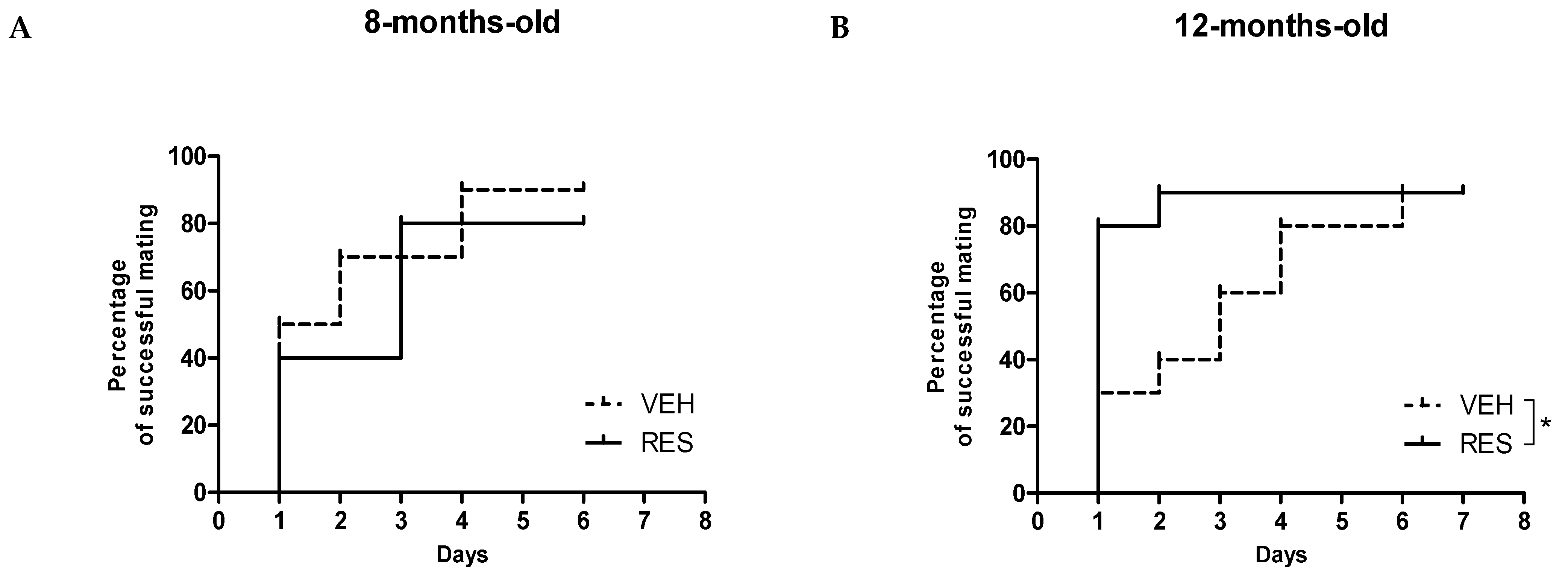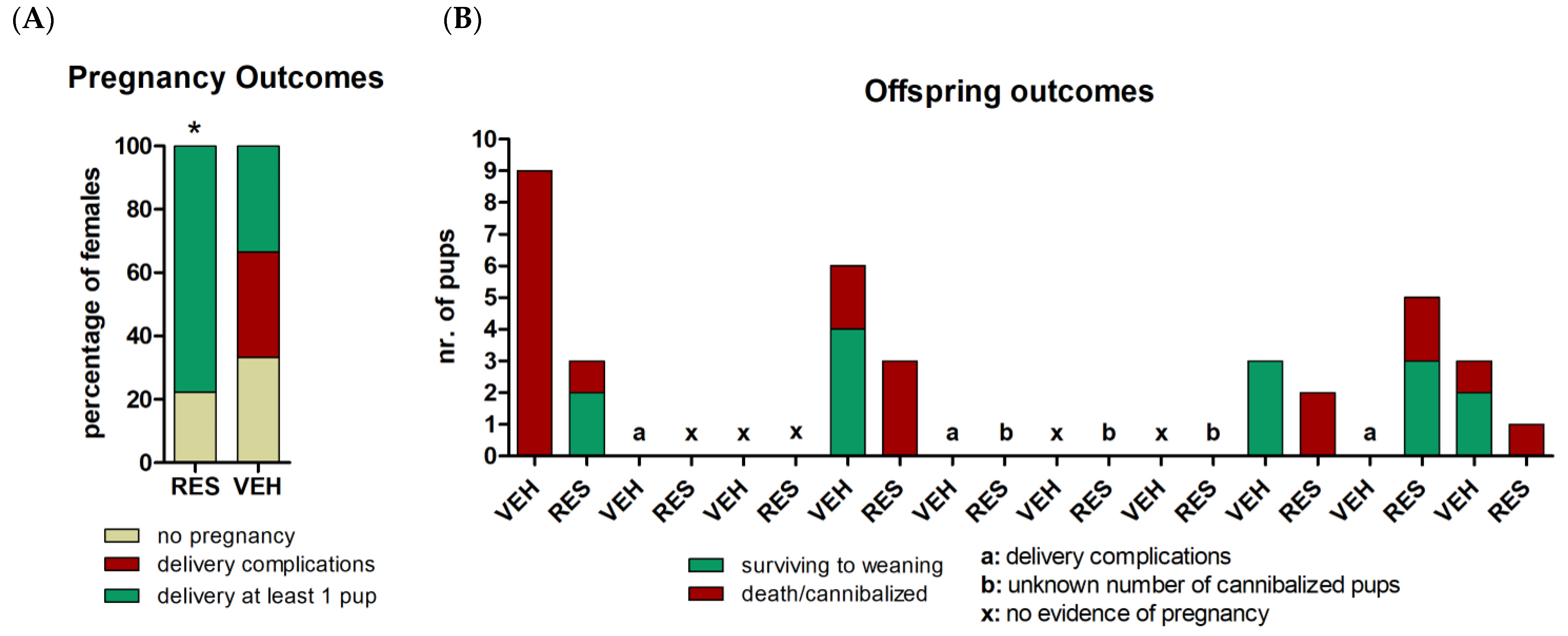Preconceptional Resveratrol Supplementation Partially Counteracts Age-Related Reproductive Complications in C57BL/6J Female Mice
Abstract
1. Introduction
2. Results
3. Discussion
4. Materials and Methods
4.1. Mice
4.2. Experimental Design
4.3. RES Supplementation to Drinking Water
4.4. Breeding
4.5. Outcomes and Statistics
5. Conclusions
Author Contributions
Funding
Institutional Review Board Statement
Informed Consent Statement
Data Availability Statement
Conflicts of Interest
Sample Availability
References
- Hamilton, B.E.; Martin, J.A.; Osterman, M.J.K.; Curtin, S.C.; Matthews, T.J. Births: Final data for 2014. Natl. Vital Stat. Rep. 2015, 64, 1–64. [Google Scholar] [PubMed]
- Haebe, J.; Martin, J.; Tekepety, F.; Tummon, I.; Shepherd, K. Success of intrauterine insemination in women aged 40–42 years. Fertil. Steril. 2002, 78, 29–33. [Google Scholar] [CrossRef]
- Dal Prato, L.; Borini, A.; Cattoli, M.; Preti, M.S.; Serrao, L.; Flamigni, C. Live birth after IVF in a 46-year-old woman. Reprod. Biomed. Online 2005, 1, 452–454. [Google Scholar] [CrossRef]
- Nassar, A.; Usta, I. Advanced maternal age. Part II: Long-term consequences. Am. J. Perinatol. 2009, 26, 107–112. [Google Scholar] [CrossRef]
- Sauer, M.V. Reproduction at an advanced maternal age and maternal health. Fertil. Steril. 2015, 103, 1136–1143. [Google Scholar] [CrossRef] [PubMed]
- Tearne, J.E. Older maternal age and child behavioral and cognitive outcomes: A review of the literature. Fertil. Steril. 2015, 103, 1381–1391. [Google Scholar] [CrossRef] [PubMed]
- Lean, S.C.; Derricott, H.; Jones, R.L.; Heazell, A.E.P. Advanced maternal age and adverse pregnancy outcomes: A systematic review and meta-analysis. PLoS ONE 2017, 12, e0186287. [Google Scholar] [CrossRef]
- McCubrey, J.A.; Lertpiriyapong, K.; Steelman, L.S.; Abrams, S.L.; Yang, L.V.; Murata, R.M.; Rosalen, P.L.; Scalisi, A.; Neri, L.M.; Cocco, L.; et al. Effects of resveratrol, curcumin, berberine and other nutraceuticals on aging, cancer development, cancer stem cells and microRNAs. Aging 2017, 9, 1477–1536. [Google Scholar] [CrossRef]
- Smoliga, J.M.; Baur, J.A.; Hausenblas, H.A. Resveratrol and health–A comprehensive review of human clinical trials. Mol. Nutr. Food Res. 2011, 55, 1129–1141. [Google Scholar] [CrossRef]
- Wung, B.S.; Hsu, M.C.; Wu, C.C.; Hsieh, C.W. Resveratrol suppresses IL-6-induced ICAM-1 gene expression in endothelial cells: Effects on the inhibition of STAT3 phosphorylation. Life Sci. 2005, 78, 389–397. [Google Scholar] [CrossRef]
- Csiszar, A.; Smith, K.; Labinskyy, N.; Orosz, Z.; Rivera, A.; Ungvari, Z. Resveratrol attenuates TNF-α-induced activation of coronary arterial endothelial cells: Role of NF-κB inhibition. Am. J. Physiol. Heart Circ. Physiol. 2006, 291, H1694–H1699. [Google Scholar] [CrossRef]
- Baur, J.A.; Pearson, K.J.; Price, N.L.; Jamieson, H.A.; Lerin, C.; Kalra, A.; Prabhu, V.V.; Allard, J.S.; Lopez-Lluch, G.; Lewis, K.; et al. Resveratrol improves health and survival of mice on a high-calorie diet. Nature 2006, 444, 337–342. [Google Scholar] [CrossRef]
- Breuss, J.; Atanasov, A.; Uhrin, P. Resveratrol and its effects on the vascular system. Int. J. Mol. Sci. 2019, 20, 1523. [Google Scholar] [CrossRef]
- Yeung, A.W.K.; Bhushan Aggarwal, B.; Erdogan Orhan, I.; Horbańczuk, O.K.; Barreca, D.; Battino, M.; Belwal, T.; Bishayee, A.; Daglia, M.; Devkota, H.A.; et al. Resveratrol, a popular dietary supplement for human and animal health: Quantitative research literature analysis—A review. Anim. Sci. Pap. Rep. 2019, 37, 103–118. [Google Scholar]
- Patel, K.R.; Scott, E.; Brown, V.A.; Gescher, A.J.; Steward, W.P.; Brown, K. Clinical trials of resveratrol: Clinical trials. Ann. N. Y. Acad. Sci. 2011, 1215, 161–169. [Google Scholar] [CrossRef]
- Barger, J.L.; Kayo, T.; Vann, J.M.; Arias, E.B.; Wang, J.; Hacker, T.A.; Wang, Y.; Raederstorff, D.; Morrow, J.D.; Leeuwenburgh, C.; et al. A low dose of dietary resveratrol partially mimics caloric restriction and retards aging parameters in mice. PLoS ONE 2008, 3, e2264. [Google Scholar] [CrossRef]
- Pearson, K.J.; Baur, J.A.; Lewis, K.N.; Peshkin, L.; Price, N.L.; Labinskyy, N.; Swindell, W.R.; Kamara, D.; Minor, R.K.; Perez, E.; et al. Resveratrol delays age-related deterioration and mimics transcriptional aspects of dietary restriction without extending life span. Cell Metab. 2008, 8, 157–168. [Google Scholar] [CrossRef] [PubMed]
- Zheng, S.; Feng, Q.; Cheng, J.; Zheng, J. Maternal resveratrol consumption and its programming effects on metabolic health in offspring mechanisms and potential implications. Biosci. Rep. 2018, 38, BSR20171741. [Google Scholar] [CrossRef]
- Singh, C.K.; Kumar, A.; Hitchcock, D.B.; Fan, D.; Goodwin, R.; LaVoie, H.A.; Nagarkatti, P.; DiPette, D.J.; Singh, U.S. Resveratrol prevents embryonic oxidative stress and apoptosis associated with diabetic embryopathy and improves glucose and lipid profile of diabetic dam. Mol. Nutr. Food Res. 2011, 55, 1186–1196. [Google Scholar] [CrossRef]
- Williams, L.D.; Burdock, G.A.; Edwards, J.A.; Beck, M.; Bausch, J. Safety studies conducted on high-purity trans-resveratrol in experimental animals. Food Chem. Toxicol. 2009, 47, 2170–2182. [Google Scholar] [CrossRef]
- Bhullar, K.S.; Hubbard, B.P. Lifespan and healthspan extension by resveratrol. Biochim. Biophys. Acta 2015, 1852, 1209–1218. [Google Scholar] [CrossRef]
- Pasquariello, R.; Verdile, N.; Brevini, T.A.L.; Gandolfi, F.; Boiti, C.; Zerani, M.; Maranesi, M. The role of resveratrol in mammalian reproduction. Molecules 2020, 25, 4554. [Google Scholar] [CrossRef]
- Day, J.R.; La Polt, P.S.; Morales, T.H.; Lu, J.K. An abnormal pattern of embryonic development during early pregnancy in aging rats. Biol. Reprod. 1989, 41, 933–939. [Google Scholar] [CrossRef]
- Finn, C.A. Reproductive capacity and litter size in mice: Effect of age and environment. Reproduction 1963, 6, 205–214. [Google Scholar] [CrossRef]
- Scoggin, C.F. Not just a number: Effect of age on fertility, pregnancy and offspring vigour in thoroughbred brood-mares. Reprod. Fertil. Dev. 2015, 27, 872. [Google Scholar] [CrossRef]
- Shorten, P.R.; Morris, C.A.; Cullen, N.G. The effects of age, weight, and sire on pregnancy rate in cattle. J. Anim. Sci. 2015, 93, 1535–1545. [Google Scholar] [CrossRef]
- Woods, L.; Perez-Garcia, V.; Kieckbusch, J.; Wang, X.; DeMayo, F.; Colucci, F.; Hemberger, M. Decidualisation and placentation defects are a major cause of age-related reproductive decline. Nat. Commun. 2017, 8. [Google Scholar] [CrossRef]
- Sampino, S.; Stankiewicz, A.M.; Zacchini, F.; Goscik, J.; Szostak, A.; Swiergiel, A.H.; Drago, G.; Modlinski, J.A.; Ptak, G.E. Pregnancy at advanced maternal age affects behavior and hippocampal gene expression in mouse offspring. J. Gerontol. A Biol. Sci. Med. Sci. 2017, 72, 1465–1473. [Google Scholar] [CrossRef]
- Ziętek, M.; Sampino, S. Pregnancy-related gene-environment interactions modulate the risk for autism-like behavioral disorders in mouse offspring. Unpublished (manuscript currently in preparation).
- Meziane, H.; Ouagazzal, A.-M.; Aubert, L.; Wietrzych, M.; Krezel, W. Estrous cycle effects on behavior of C57BL/6J and BALB/cByJ female mice: Implications for phenotyping strategies. Genes Brain Behav. 2007, 6, 192–200. [Google Scholar] [CrossRef]
- Zordoky, B.N.M.; Robertson, I.M.; Dyck, J.R.B. Preclinical and clinical evidence for the role of resveratrol in the treatment of cardiovascular diseases. Biochim. Biophys. Acta 2015, 1852, 1155–1177. [Google Scholar] [CrossRef]
- Ortega, I.; Duleba, A.J. Ovarian actions of resveratrol: Ovarian actions of resveratrol. Ann. N. Y. Acad. Sci. 2015, 1348, 86–96. [Google Scholar] [CrossRef]
- Liu, M.; Yin, Y.; Ye, X.; Zeng, M.; Zhao, Q.; Keefe, D.L.; Liu, L. Resveratrol protects against age-associated infertility in mice. Hum. Reprod. 2013, 28, 707–717. [Google Scholar] [CrossRef] [PubMed]
- Ochiai, A.; Kuroda, K.; Ozaki, R.; Ikemoto, Y.; Murakami, K.; Muter, J.; Matsumoto, A.; Itakura, A.; Brosens, J.J.; Takeda, S. Resveratrol inhibits decidualization by accelerating downregulation of the CRABP2-RAR pathway in differentiating human endometrial stromal cells. Cell Death Dis. 2019, 10, 276. [Google Scholar] [CrossRef]


| Evidence of Pregnancy at 0.5 dpc No. (%) | Evidence of Pregnancy at 18 dpc No. (%) | Litter Size at Delivery b Mean ± SEM | Offspring at 21 Days Postnatal No. | |
|---|---|---|---|---|
| Resveratrol | 9/10 (90%) | 7/9 (78%) | 2.8 ± 1.4 | 5 |
| Vehicle | 9/9 (100%) a | 6/9 (67%) | 5.2 ± 2.8 | 9 |
Publisher’s Note: MDPI stays neutral with regard to jurisdictional claims in published maps and institutional affiliations. |
© 2021 by the authors. Licensee MDPI, Basel, Switzerland. This article is an open access article distributed under the terms and conditions of the Creative Commons Attribution (CC BY) license (https://creativecommons.org/licenses/by/4.0/).
Share and Cite
Ziętek, M.; Barłowska, K.; Wijas, B.; Szablisty, E.; Atanasov, A.G.; Modliński, J.A.; Świergiel, A.H.; Sampino, S. Preconceptional Resveratrol Supplementation Partially Counteracts Age-Related Reproductive Complications in C57BL/6J Female Mice. Molecules 2021, 26, 1934. https://doi.org/10.3390/molecules26071934
Ziętek M, Barłowska K, Wijas B, Szablisty E, Atanasov AG, Modliński JA, Świergiel AH, Sampino S. Preconceptional Resveratrol Supplementation Partially Counteracts Age-Related Reproductive Complications in C57BL/6J Female Mice. Molecules. 2021; 26(7):1934. https://doi.org/10.3390/molecules26071934
Chicago/Turabian StyleZiętek, Marta, Katarzyna Barłowska, Barbara Wijas, Ewa Szablisty, Atanas G. Atanasov, Jacek A. Modliński, Artur H. Świergiel, and Silvestre Sampino. 2021. "Preconceptional Resveratrol Supplementation Partially Counteracts Age-Related Reproductive Complications in C57BL/6J Female Mice" Molecules 26, no. 7: 1934. https://doi.org/10.3390/molecules26071934
APA StyleZiętek, M., Barłowska, K., Wijas, B., Szablisty, E., Atanasov, A. G., Modliński, J. A., Świergiel, A. H., & Sampino, S. (2021). Preconceptional Resveratrol Supplementation Partially Counteracts Age-Related Reproductive Complications in C57BL/6J Female Mice. Molecules, 26(7), 1934. https://doi.org/10.3390/molecules26071934







